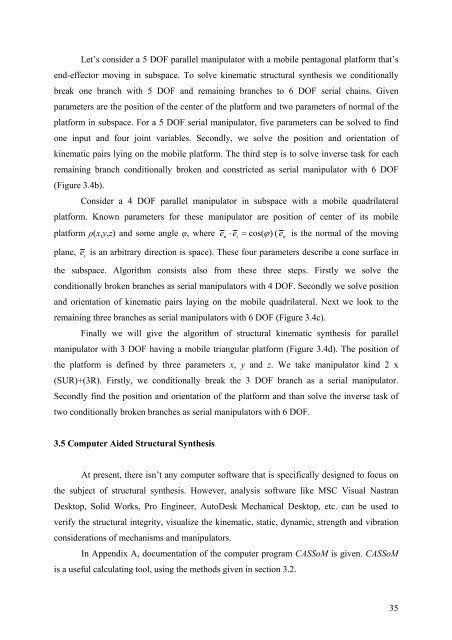Kinematic and Dynamic Analysis of Spatial Six Degree of Freedom ...
Kinematic and Dynamic Analysis of Spatial Six Degree of Freedom ...
Kinematic and Dynamic Analysis of Spatial Six Degree of Freedom ...
Create successful ePaper yourself
Turn your PDF publications into a flip-book with our unique Google optimized e-Paper software.
Let’s consider a 5 DOF parallel manipulator with a mobile pentagonal platform that’s<br />
end-effector moving in subspace. To solve kinematic structural synthesis we conditionally<br />
break one branch with 5 DOF <strong>and</strong> remaining branches to 6 DOF serial chains. Given<br />
parameters are the position <strong>of</strong> the center <strong>of</strong> the platform <strong>and</strong> two parameters <strong>of</strong> normal <strong>of</strong> the<br />
platform in subspace. For a 5 DOF serial manipulator, five parameters can be solved to find<br />
one input <strong>and</strong> four joint variables. Secondly, we solve the position <strong>and</strong> orientation <strong>of</strong><br />
kinematic pairs lying on the mobile platform. The third step is to solve inverse task for each<br />
remaining branch conditionally broken <strong>and</strong> constricted as serial manipulator with 6 DOF<br />
(Figure 3.4b).<br />
Consider a 4 DOF parallel manipulator in subspace with a mobile quadrilateral<br />
platform. Known parameters for these manipulator are position <strong>of</strong> center <strong>of</strong> its mobile<br />
platform ρ(x,y,z) <strong>and</strong> some angle φ, where e n ⋅ ei<br />
= cos(ϕ ) ( e n is the normal <strong>of</strong> the moving<br />
plane, e i is an arbitrary direction is space). These four parameters describe a cone surface in<br />
the subspace. Algorithm consists also from these three steps. Firstly we solve the<br />
conditionally broken branches as serial manipulators with 4 DOF. Secondly we solve position<br />
<strong>and</strong> orientation <strong>of</strong> kinematic pairs laying on the mobile quadrilateral. Next we look to the<br />
remaining three branches as serial manipulators with 6 DOF (Figure 3.4c).<br />
Finally we will give the algorithm <strong>of</strong> structural kinematic synthesis for parallel<br />
manipulator with 3 DOF having a mobile triangular platform (Figure 3.4d). The position <strong>of</strong><br />
the platform is defined by three parameters x, y <strong>and</strong> z. We take manipulator kind 2 x<br />
(SUR)+(3R). Firstly, we conditionally break the 3 DOF branch as a serial manipulator.<br />
Secondly find the position <strong>and</strong> orientation <strong>of</strong> the platform <strong>and</strong> than solve the inverse task <strong>of</strong><br />
two conditionally broken branches as serial manipulators with 6 DOF.<br />
3.5 Computer Aided Structural Synthesis<br />
At present, there isn’t any computer s<strong>of</strong>tware that is specifically designed to focus on<br />
the subject <strong>of</strong> structural synthesis. However, analysis s<strong>of</strong>tware like MSC Visual Nastran<br />
Desktop, Solid Works, Pro Engineer, AutoDesk Mechanical Desktop, etc. can be used to<br />
verify the structural integrity, visualize the kinematic, static, dynamic, strength <strong>and</strong> vibration<br />
considerations <strong>of</strong> mechanisms <strong>and</strong> manipulators.<br />
In Appendix A, documentation <strong>of</strong> the computer program CASSoM is given. CASSoM<br />
is a useful calculating tool, using the methods given in section 3.2.<br />
35
















